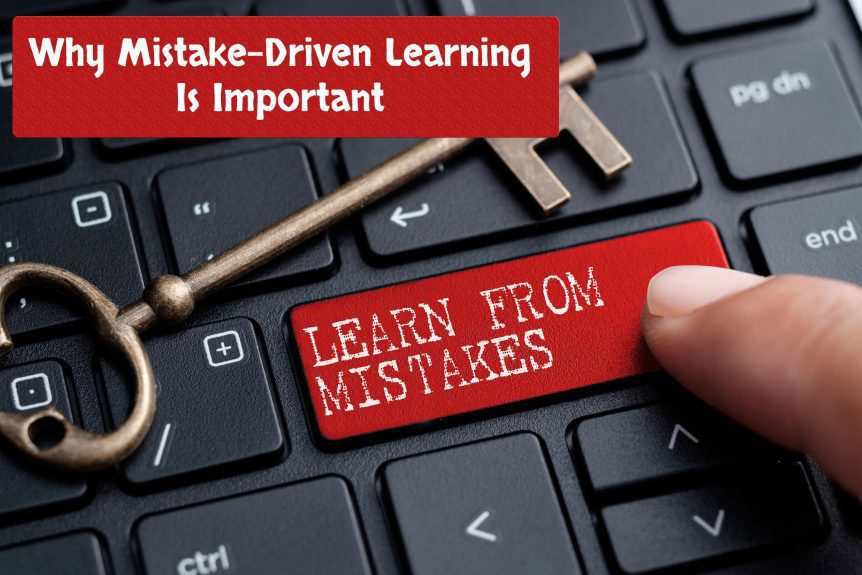Why Mistake-Driven Learning Is Important
There are a lot of metrics that measure the effectiveness of e-learning courses. Ensuring learners get good results on quizzes and other tools for assessing competence are high up on the list. In other words, the drive is usually to make sure that learners answer questions correctly when asked.
While it may sound counter-intuitive, there is a place for facilitating learners making mistakes. This is known as mistake-driven learning.
Of course, it is tempting to walk learners through a course, holding their hand every step of the way to help them get through the content with as little hassle as possible.
Learning from mistakes, however, is an important part of our personal and professional development.
Just look at any successful businessperson or entrepreneur in Dubai or around the world. They will almost always say they have made mistakes in their career and that those mistakes made them not only a better person, but better equipped to achieve success.
Mistakes Are Powerful Learning Experiences
It’s also important to remember that mistakes do not usually occur randomly. When you assess them further, you realise that instead of coming out of the blue, mistakes often occur because of incorrect assumptions, misguided understandings, and a lack of knowledge.
This is one of the reasons why making a mistake is such a significant learning experience. The mistake brings clarity and corrects wrongly held beliefs and outdated or misunderstood knowledge.
How You Can Use Mistake-Driven Learning in Your E-Learning Courses
There are a number of ways you can introduce mistake-driven learning to your e-learning courses. Two of the easiest and most common, however, are in scenarios and in your content.
In content, don’t just use stories and examples of individuals and teams making the right decisions and being successful. You should also include examples of when things go wrong, highlighting the mistakes made along the way that contributed to the failure.
In scenarios, tighten up the options you present to learners to make the answer less obvious. Then, when learners choose the incorrect answer, don’t just tell them they are wrong. Instead, explain why the learner is wrong and include details of the consequences that result from their decision.
Also, you should not look at scenarios as content elements where it is important the learner gets the right answer. In other words, answering correctly should not be your objective when creating a scenario.
A much more effective way to use scenarios is as a learning tool. The difference between the two – an assessment you want the learner to get right or a learning tool – is subtle, but the distinction is important.
The Benefits of Mistake-Driven Learning
- Mistake-driven learning helps to connect the dots between the concepts and ideas employees are learning to the experience of their day-to-day duties. In other words, it makes the learning experience more real rather than being something that is overly sanitised and controlled.
- Gives learners the opportunity to take risks in a controlled environment that will have no impact on your customers or your business in general. This is beneficial as the risks that mistake-driven learning facilitates are unlikely to be taken by learners in any other context. However, within the e-learning environment, they can take these risks, often learning more from the experience than any other form of content you can present.
- In real-world situations, employees are often faced with situations that are not black or white, or that have no clear path to resolution. Mistakes can – and do – happen in these situations. Letting learners make these mistakes during an exercise or scenario in an e-learning course will give them knowledge and experience that they can then take into those real-world situations.
- Mistake-driven learning also improves problem-solving abilities. After all, it’s impossible to outline a procedure that instructs employees on how to deal with every eventuality they will face. They will always encounter situations they will have to figure out by themselves. This requires problem-solving abilities, a skill that doesn’t always involve making the right decision or judging a situation correctly. You can help learners develop by presenting them with situations that require their problem-solving abilities, avoiding the temptation to walk them along the path to the correct answer. Let them make mistakes along the way, getting to a conclusion by themselves. They will learn much more in the process.
- You will find that knowledge retention rates also improve when you use mistake-driven learning. With mistake-driven learning, learners have to work at understanding the ideas, topics, and concepts you present them with. They also need to understand why their decision is wrong and how they made the mistake. This process will reinforce and embed knowledge better than most other learning techniques.
- Mistake-driven learning demonstrates the consequences of decisions. Letting learners make these mistakes and then explaining the consequences has much more of an impact than explaining the mistake cold.
- Making mistakes in an environment that employees trust and feel comfortable in also helps them to overcome the fear of failure as well as improving confidence. If you need people to think for themselves, try new things, be innovative, and push the boundaries of expectation and possibility, this can be invaluable.
Refining Your Approach
For most e-learning topics and in most circumstances, implementing mistake-driven learning should not be a radical shift. Instead, it’s about changing your mindset and making refinements to your courses and modules to embrace mistakes and use them as a learning experience.
